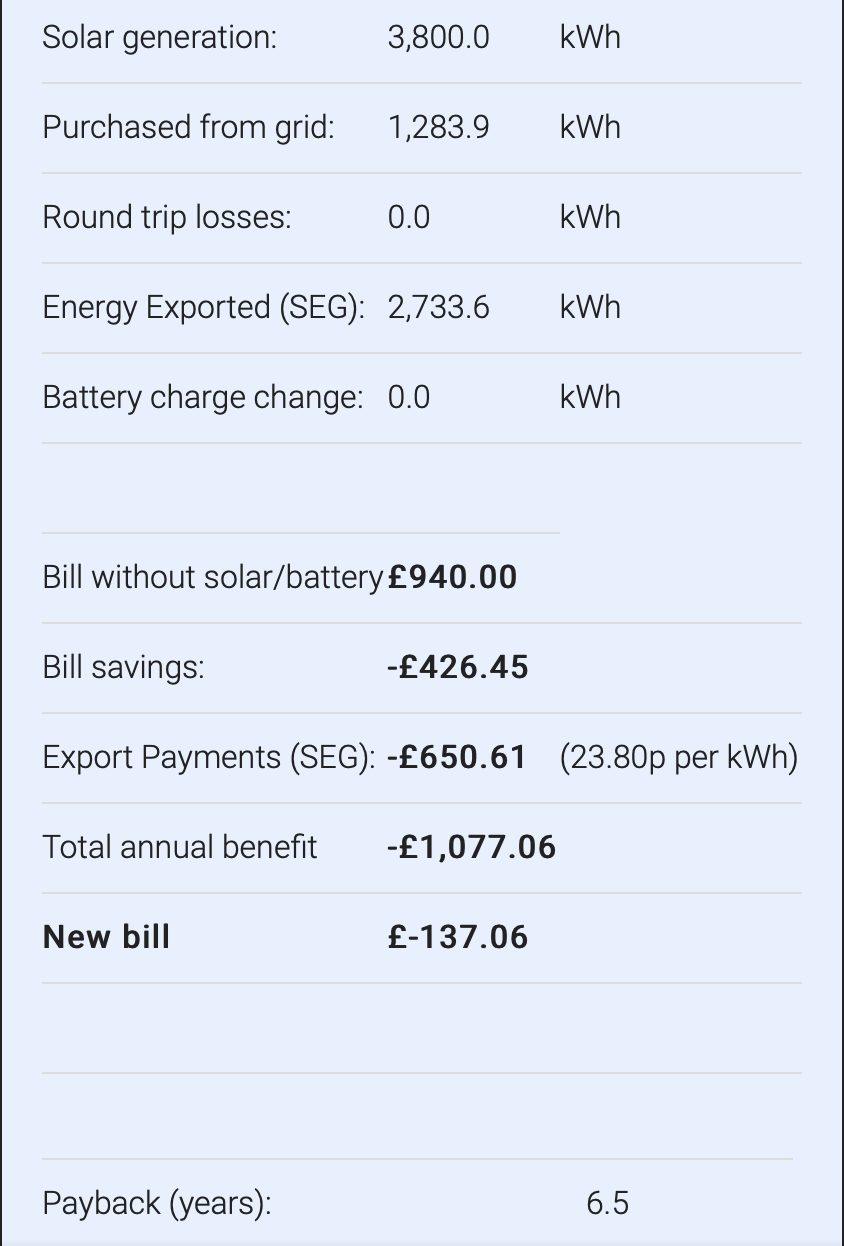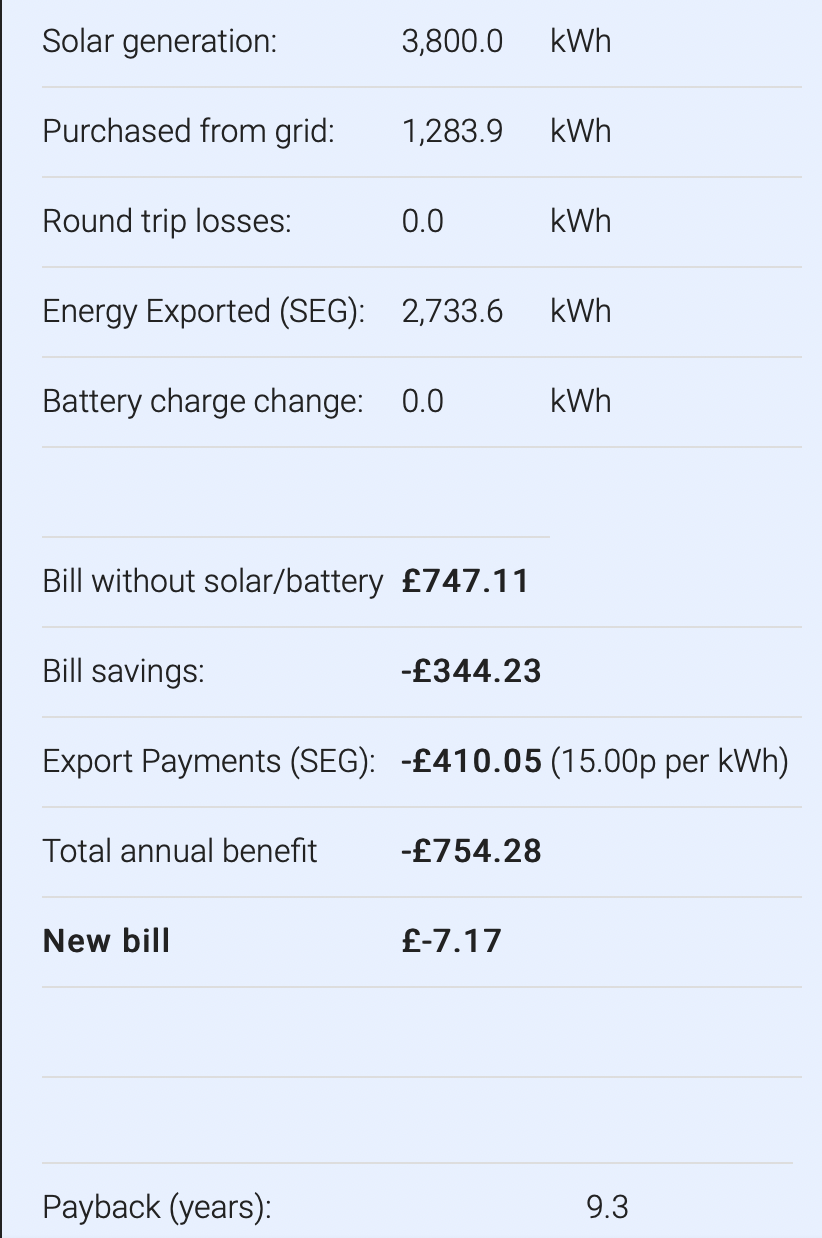We’d like to remind Forumites to please avoid political debate on the Forum.
This is to keep it a safe and useful space for MoneySaving discussions. Threads that are – or become – political in nature may be removed in line with the Forum’s rules. Thank you for your understanding.
📨 Have you signed up to the Forum's new Email Digest yet? Get a selection of trending threads sent straight to your inbox daily, weekly or monthly!
New Octopus tariff for solar and battery users - Octopus Flux
Comments
-
PV only (no battery) household. Simple side by side estimates highlight a significant savings with a few conditions:
1) We will have to run our laundry/ dishwasher appliances between 2-5am exclusively.
2) We will export through the day, during the peak 4-7pm window, when our consumption will be minimal.
3) It is unlikely the Flux tariff will remain lucrative during the October-March period.
It would appear that the Flux tariff further weakens the financial case in favour of home battery storage during the peak PV period.
FLUX
VS.
AGILE
- 10 x 400w LG Bifacial + 6 x 550W SHARP BiFacial + 2 x 570W SHARP Bifacial + 5kW SolarEdge Inverter + SolarEdge Optimizers. SE London.
- Triple aspect. (33% ENE.33% SSE. 34% WSW)
- Viessmann 200-W on Advanced Weather Comp. (The most efficient gas boiler sold)Feel free to DM me for help with any form of energy saving! Happy to help!0 -
Yes, other (cheaper) batteries do exist and two neighbours / friends have invested in GivEnergy. I know one is pleased and I haven't had a chance to catch up with the other. However, compared to the more expensive Powerwall:Ron-ski said:@pensionpawn Newsflash, other batteries are available Someone I know has just installed a 5.2kWh battery (8yr UK warranty), cost £1350, Solis 3kW inverter, cost £649, add in a little bit extra for cables etc and he has paid just over £2k, he has another two batteries on order.Edit. I don't think you've factored in using cheap rate electric through the winter, this will decrease the costs further, or the smug feeling you get seeing how small your electric bill is
Someone I know has just installed a 5.2kWh battery (8yr UK warranty), cost £1350, Solis 3kW inverter, cost £649, add in a little bit extra for cables etc and he has paid just over £2k, he has another two batteries on order.Edit. I don't think you've factored in using cheap rate electric through the winter, this will decrease the costs further, or the smug feeling you get seeing how small your electric bill is Also don't know why people are so concerned with ROI in the warranty period, they don't suddenly stop working.
Also don't know why people are so concerned with ROI in the warranty period, they don't suddenly stop working.
1. They are 9.5 kWhrs c/f 13.5 kWhrs
2. They don't come with a built in inverter, so that is an additional cost.
3. Their maximum charge / discharge power is 3 kWs c/f 5 kWs.
4. They are limited to one circuit compared to powering the whole consumer unit / house
5. They don't facilitate "island mode" to keep your house running after a power cut.
It's horses for courses, I'm only suggesting that a battery isn't cost effective for me at present, preferring to wait until bi-direction car chargers (Indra..) are commercially viable / cost effective, at which point I'll consider my first EV.
Out of interest I've just modelled the last 7 days as if I was on Flux and I noted the following:
Standard export 84.5 (£19.03)
Flux export 12 (£4.31)
Night import 11.1 (£2.23)
Day import 44 (£14.75)
Flux import 5.8 (£2.72)
Leaving me with + £3.64 to offset a slight increase in gas consumption due to solar divert now being exported.
£22.62 generation FiT over the same period suggesting, as I expected, Flux to be a very rewarding tariff April - September (maybe October) inc, no battery required.
1 -
And there's a lot cheaper batteries than Givenergy as well
 0
0 -
I've left my battery in max self consumption mode since switching, haven't run out of battery overnight yet and have found I'm exporting plenty in the peak times. Once I've got a couple month worth of date I'll be able.to compare to previous agile rates.
All looking good so far though.
Will this nit work in the winter?
I can get through a day with 10kw so as long as I fill up I'll still be better off.
Could switch to Go in October I suppose and do the same thing.4.3kwp JA panels, Huawei 3.68kw Hybrid inverter, Huawei 10kw Lunar 2000 battery, Myenergi eddi, South facing array with a 15 degree roof pitch, winter shade.0 -
No doubt there are, however for me (for the reasons given above) they don't appeal at present. There is also the consideration that if you pay out for batteries just to time shift energy, where does that leave someone if Octopus withdraw Flux and similar tariffs? I believe this is the direction of travel, albeit over a long time frame, as ultimately the push, and increasing migration, to night time energy use will increasingly flatten out the daily curve and associated "time of use" tariffs. When battery tech becomes fiscally enticing, and can do everything that I want it to do, I will adopt. In the meantime there are other more lucrative destinations for my spare cash.Ron-ski said:And there's a lot cheaper batteries than Givenergy as well 1
1 -
pensionpawn said:No doubt there are, however for me (for the reasons given above) they don't appeal at present. There is also the consideration that if you pay out for batteries just to time shift energy, where does that leave someone if Octopus withdraw Flux and similar tariffs? I believe this is the direction of travel, albeit over a long time frame, as ultimately the push, and increasing migration, to night time energy use will increasingly flatten out the daily curve and associated "time of use" tariffs. When battery tech becomes fiscally enticing, and can do everything that I want it to do, I will adopt. In the meantime there are other more lucrative destinations for my spare cash.

Slow Clap!- 10 x 400w LG Bifacial + 6 x 550W SHARP BiFacial + 2 x 570W SHARP Bifacial + 5kW SolarEdge Inverter + SolarEdge Optimizers. SE London.
- Triple aspect. (33% ENE.33% SSE. 34% WSW)
- Viessmann 200-W on Advanced Weather Comp. (The most efficient gas boiler sold)Feel free to DM me for help with any form of energy saving! Happy to help!0 -
pensionpawn said:
No doubt there are, however for me (for the reasons given above) they don't appeal at present. There is also the consideration that if you pay out for batteries just to time shift energy, where does that leave someone if Octopus withdraw Flux and similar tariffs? I believe this is the direction of travel, albeit over a long time frame, as ultimately the push, and increasing migration, to night time energy use will increasingly flatten out the daily curve and associated "time of use" tariffs. When battery tech becomes fiscally enticing, and can do everything that I want it to do, I will adopt. In the meantime there are other more lucrative destinations for my spare cash.Ron-ski said:And there's a lot cheaper batteries than Givenergy as well Good job I've got plenty of panels
Good job I've got plenty of panels Good point you make about eventually losing the cheap rate periods, it could happen, but then surely people will drift back to using power as and when they want as there would be no incentive not to.I wouldn't recommend having just batteries, but I know people that have added batteries pretty cheaply to an existing PV installation, 3kW inverter and 5.2 kWh battery for circa £2k, additional 5.2kWh batteries are £1.3k, and come from a UK manufacture (Fogstar) and have an 8yr warranty. 15kWh set £4k, 30kWh set £8k, both in a nice server rack cabinet made for the job. Want more power, use a more powerful inverter.What do you want battery tech to do that it doesn't?
Good point you make about eventually losing the cheap rate periods, it could happen, but then surely people will drift back to using power as and when they want as there would be no incentive not to.I wouldn't recommend having just batteries, but I know people that have added batteries pretty cheaply to an existing PV installation, 3kW inverter and 5.2 kWh battery for circa £2k, additional 5.2kWh batteries are £1.3k, and come from a UK manufacture (Fogstar) and have an 8yr warranty. 15kWh set £4k, 30kWh set £8k, both in a nice server rack cabinet made for the job. Want more power, use a more powerful inverter.What do you want battery tech to do that it doesn't?
0 -
Plenty of panels (4 due east and 3.1 due west) here too as 8 years ago I had a feeling that I couldn't have too many panels in the future, even if it meant taking a hit on the top rate of FiT (for exceeding 4kWs). I had a gut feeling that maximising (~4.5 Mwhrs) spare capacity pa would prove the better strategy over the long game. To be honest, I did order a Powerwall in February 2022 as my modelling suggested that the price point was as optimal as it would get (RoI ~ 6 years). However it was delayed, then the price increased and the final nail in the coffin was a change in our lifestyles which has fundamentally changed our energy needs. My wife retired last August and I've reduced my hours so I'm effectively in the office for only half the year. That has allowed us to shift our heavy loads (manually) to peak solar generation, massively reducing our annual import (down over 1 Mwhr in around 6 months). Hence significantly reducing the benefit of a battery. A situation that was impossible to model before running through it. This has also dovetailed nicely into Octopus's Flux tariff as the due west facing array combined with the flexibility of cooking / cleaning our main meal at lunchtime, allows us to dump the majority of our natural 16:00 - 19:00 generation for prime export.Ron-ski said:pensionpawn said:
No doubt there are, however for me (for the reasons given above) they don't appeal at present. There is also the consideration that if you pay out for batteries just to time shift energy, where does that leave someone if Octopus withdraw Flux and similar tariffs? I believe this is the direction of travel, albeit over a long time frame, as ultimately the push, and increasing migration, to night time energy use will increasingly flatten out the daily curve and associated "time of use" tariffs. When battery tech becomes fiscally enticing, and can do everything that I want it to do, I will adopt. In the meantime there are other more lucrative destinations for my spare cash.Ron-ski said:And there's a lot cheaper batteries than Givenergy as well Good job I've got plenty of panels
Good job I've got plenty of panels Good point you make about eventually losing the cheap rate periods, it could happen, but then surely people will drift back to using power as and when they want as there would be no incentive not to.I wouldn't recommend having just batteries, but I know people that have added batteries pretty cheaply to an existing PV installation, 3kW inverter and 5.2 kWh battery for circa £2k, additional 5.2kWh batteries are £1.3k, and come from a UK manufacture (Fogstar) and have an 8yr warranty. 15kWh set £4k, 30kWh set £8k, both in a nice server rack cabinet made for the job. Want more power, use a more powerful inverter.What do you want battery tech to do that it doesn't?
Good point you make about eventually losing the cheap rate periods, it could happen, but then surely people will drift back to using power as and when they want as there would be no incentive not to.I wouldn't recommend having just batteries, but I know people that have added batteries pretty cheaply to an existing PV installation, 3kW inverter and 5.2 kWh battery for circa £2k, additional 5.2kWh batteries are £1.3k, and come from a UK manufacture (Fogstar) and have an 8yr warranty. 15kWh set £4k, 30kWh set £8k, both in a nice server rack cabinet made for the job. Want more power, use a more powerful inverter.What do you want battery tech to do that it doesn't?
So what do I additionally want from battery tech? Well, island mode is highly desirable, to keep the lights on when the grid goes down. It could be a tad frustrating if outages start to occur in future due to weather extremes / rationing and all those kWhrs of battery storage are sat there as useful as a chocolate teapot. Yes, you could probably add a home gateway system at a later stage, however that's not desirable to me. I am also interested in my battery having four wheels outside and one inside, but only when that mobile battery is connected to a bi-directional charger. That mobile battery will also be 5 to 8 times larger than the current average home battery size. Finally the battery can power the whole house in an outage, rather than just a specified circuit.
I'm happy to wait.1 -
In other news, Octopus have just emailed to say that my export MPAN has just been applied for and I should see the chequered flag within a fortnight.0
-
I’d give them a gentle nudge at the end of the fortnight. There are manual steps that they also need to take and sometimes they need reminding to follow up on things!pensionpawn said:In other news, Octopus have just emailed to say that my export MPAN has just been applied for and I should see the chequered flag within a fortnight.8 x Jinko Tiger Neo 54c 415W, Huawei 3k L1 HV ph Hybrid inverter and 2 x 5kWh LUNA batteries on 15° roof facing SW on the southern edge of Bristol.1
Confirm your email address to Create Threads and Reply

Categories
- All Categories
- 352.9K Banking & Borrowing
- 253.9K Reduce Debt & Boost Income
- 454.7K Spending & Discounts
- 245.9K Work, Benefits & Business
- 602K Mortgages, Homes & Bills
- 177.8K Life & Family
- 259.8K Travel & Transport
- 1.5M Hobbies & Leisure
- 16K Discuss & Feedback
- 37.7K Read-Only Boards






